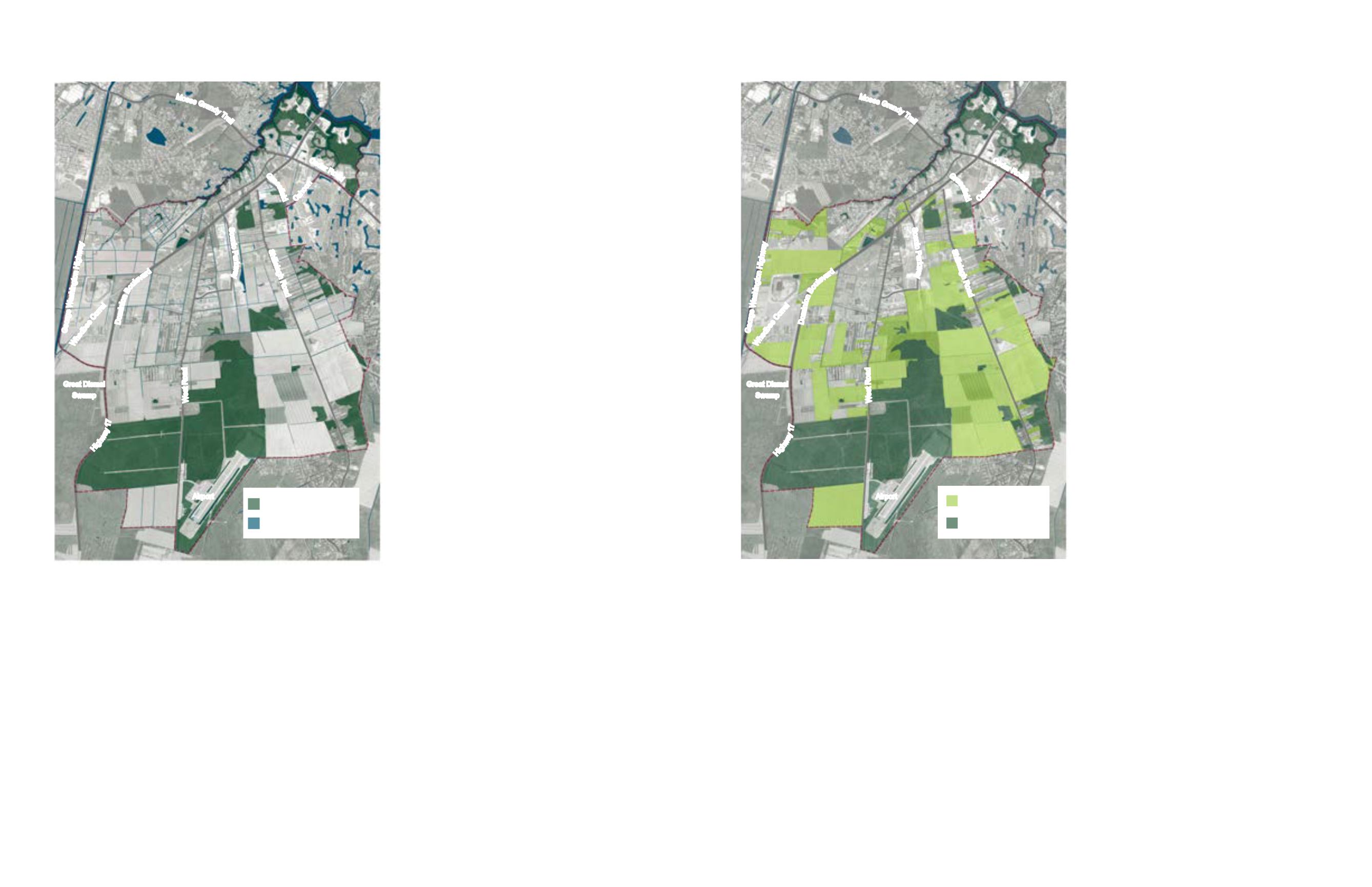
DOMINION BOULEVARD CORRIDOR STUDY | Chesapeake, Virginia
36 | Existing Conditions
Existing Conditions | 37
Landscape Features
Existing Agriculture
Existing Hydrology and National
Wetlands Inventory Map
The existing hydrological patterns are
important features and potential assets to
leverage given the Study Area’s location
next to the Great Dismal Swamp National
Wildlife Refuge Area and the Elizabeth
River.
The National Wetlands Inventory was used
to identify potential wetlands in the Study
Area. According to the inventory, most of
the site’s forested areas are likely to contain
wetlands and protect sensitive habitat and
biodiversity.
There is a large portion of potential wetlands
in the south portion of the site, providing a
connection from the Great Dismal Swamp
National Wildlife Refuge Area through the
Study Area.
Canals line the edges of properties and
many roadways to assist with stormwater
and flood management. Some of these
canals are small in scale at 1-2 feet wide,
while others, like the historic Herring Ditch,
are 20-30 feet wide.
By mapping and highlighting the hydrologic
features, new development will work in
concert with the hydrology of the Study
Area. Although this inventory is not infallible,
and some of the forested areas may turn
out not to be wetlands, it is a starting point
to identify land that is likely unsuitable
for development and should be protected
in its natural condition. This will provide
environmental as well as recreational
benefits and will promote a plan that is in
character with the Study Area’s adjacency
to the Great Dismal Swamp National Wildlife
Refuge Area.
Existing Agricultural Land
Agriculture shapes much of the image,
character and lifestyle of the Study Area. It
is something that the Community wishes to
preserve as much as practical. Protecting
agricultural resources is part of a smart,
holistic growth plan and should be taken
seriously in the Study Area.
Small scale and large scale agricultural
activity is still prevalent in the Study Area
in the form of large tracts of commercial
operations and small agricultural
homesteads. In all, approximately 4,000
acres are currently being farmed.
Many of the large farms are concentrated
along Shillelagh Road, south of the Herring
Ditch in the southeastern quadrant of the
Study Area. There are also concentrations
of agricultural activity in the western
portion of the Study Area, along Dominion
as it turns to Highway 17 and near the
George Washington Highway. Agricultural
land is also found along the south side of
Drumcastle Lane and follows on to both
sides of West Road moving south, and again
between Number Ten Lane and Herring
Ditch Road.
Mapping the land used for agriculture will
bring attention to it so that a master plan
can be created that can preserve the most
sensible portions of it - such as the large
areas located in the southern portion of the
Study Area.
Figure 18: Existing hydrologic features including canals, ditches and
forested land cataloged on the National Wetlands Inventory
Figure 19: Existing agricultural lands
Moses
G
r
a
n
d
y
T
r
a
i
l
Ceda
r Ro
a
d
Domi
n
i
o
n
B
o
u
l
e
v
a
r
d
G
r
a
s
s
i
e
l
d
Shillelagh Roa
d
George Washington Highwa
y
Hig
h
w
a
y
1
7
W
e
s
t
R
o
a
d
Scenic Pa
r
k
w
a
y
C
a
h
o
o
n
Whedbee
C
o
r
r
e
l
Airport
Great Dismal
Swamp
Moses
G
r
a
n
d
y
T
r
a
i
l
Ceda
r Ro
a
d
Domi
n
i
o
n
B
o
u
l
e
v
a
r
d
G
r
a
s
s
i
e
l
d
Shillelagh Roa
d
George Washington Highwa
y
Hig
h
w
a
y
1
7
W
e
s
t
R
o
a
d
Scenic Pa
r
k
w
a
y
C
a
h
o
o
n
Whedbee
C
o
r
r
e
l
Airport
Great Dismal
Swamp
Hydrology/Canals + Ditches
Wetlands (per NWI Inventory)
1870 acres
Forested Land
1870 acres
Existing Agricultural Land
3800 acres


